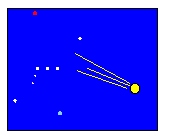 |
Astronomy 101 Problem Set #3 |  |
This Problem Set is due by 1:00 pm on Thursday, 15 September
 |
Astronomy 101 Problem Set #3 |  |
This Problem Set is due by 1:00 pm on Thursday, 15 September
Problem #1: Consider for a moment Aristarchus' measurement of the ratio of the distance to the Moon to the distance to the Sun (this was discussed in class, and it's written up in both the class notes and your text). As we mentioned in class, Aristarchus measured an angle of 87 degrees for the elongation of the First Quarter Moon. This must've been a very tough measurement without modern equipment, and, as it turns out, his value is incorrect. What value should he have measured? Look up the average Earth-Moon and Earth-Sun distances in the back of your book, and calculate the real value of the First Quarter Moon's elongation. Please show your work, including a diagram of the Sun-Moon-Earth geometry.
Problem #2: In 1989, the Hipparcos satellite was launched. Its primary purpose was to measure the parallax of nearby stars so that their distances could be calculated. Hipparcos measured the parallax shift of stars using the method described on your Parallax special web page -- it measured the difference in the direction to nearby stars due to the Earth's motion around the Sun. The satellite, which operated for three years, was remarkably successful, and was able to measure accurate parallaxes for stars as distant as 100 parsecs away. (A "parsec" is a unit of distance; look it up in the back of your book.)
So how accurately did Hipparcos have to measure angular differences? Consider a star located 100 parsecs away. Calculate the change in the direction to the star between times separated by six months (i.e., between two different times when the Earth is on either side of the Sun in its orbit).
Problem #3: I keep saying in class that the idea of a rotating Earth orbiting the Sun is preposterous, because such an idea implies that we're moving through space at an enormous speed. Let's see if we can quantify just what kind of speeds we're talking about here.
a) Let's do this in two parts. First, we'll consider how fast we're moving because of the rotation of the Earth on its axis. To make the problem easier, let's assume we live on the Equator. Based on the fact that the Earth rotates once in a day (what kind of day?), we can calculate how fast a person on the Equator is moving. Do it.
b) Now let's figure out how fast the Earth moves in its orbit around the Sun. How long does it take for the Earth to take one lap around the Sun? And how far is that? (You may assume here that the Earth's orbit is circular here.) With these quantities, calculate the speed of the Earth in its orbit around the Sun.
c) Lastly, let's compare these speeds to speeds of everyday things. How many times faster than a speeding car (say, at 65 mph) is our planet rotating and orbiting? Calculate the ratios of our planet's rotational and orbital speeds to the speed of such a car. Your answer should be in the form, "The Earth's orbital speed is 72 times faster than the speed of a car" or something like that. (It may help to remember from lab that 1 m/s = 2.24 mph).
